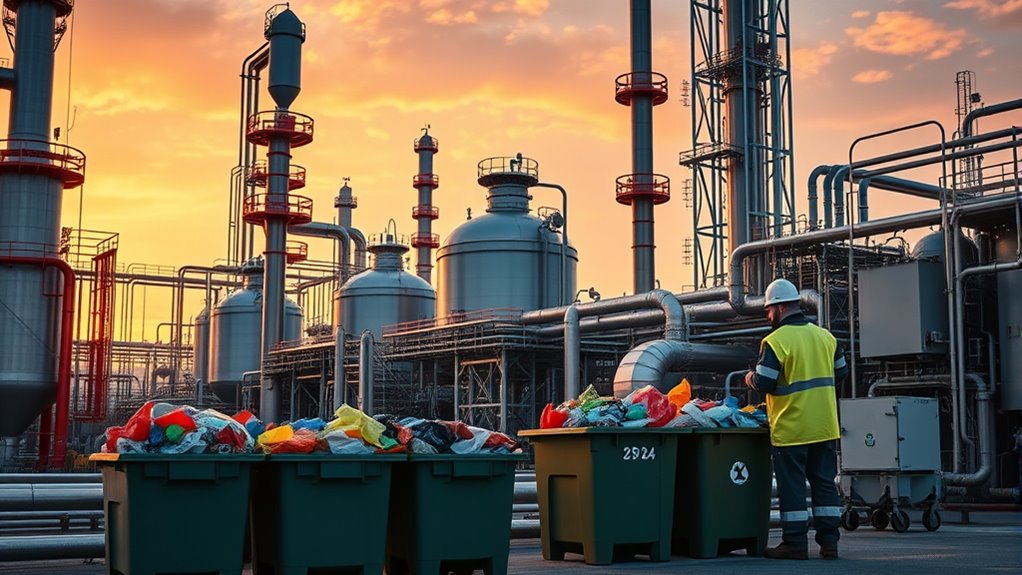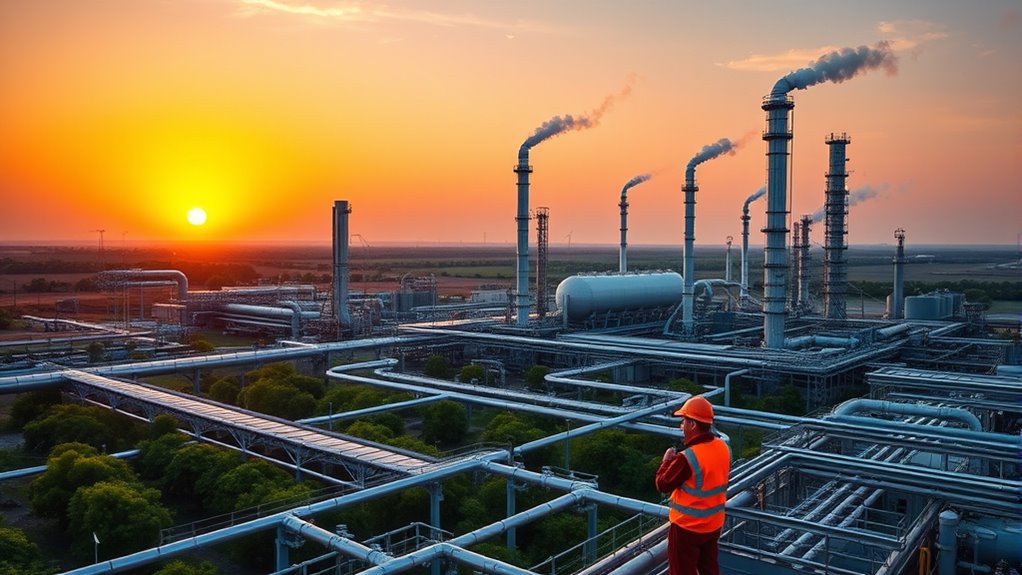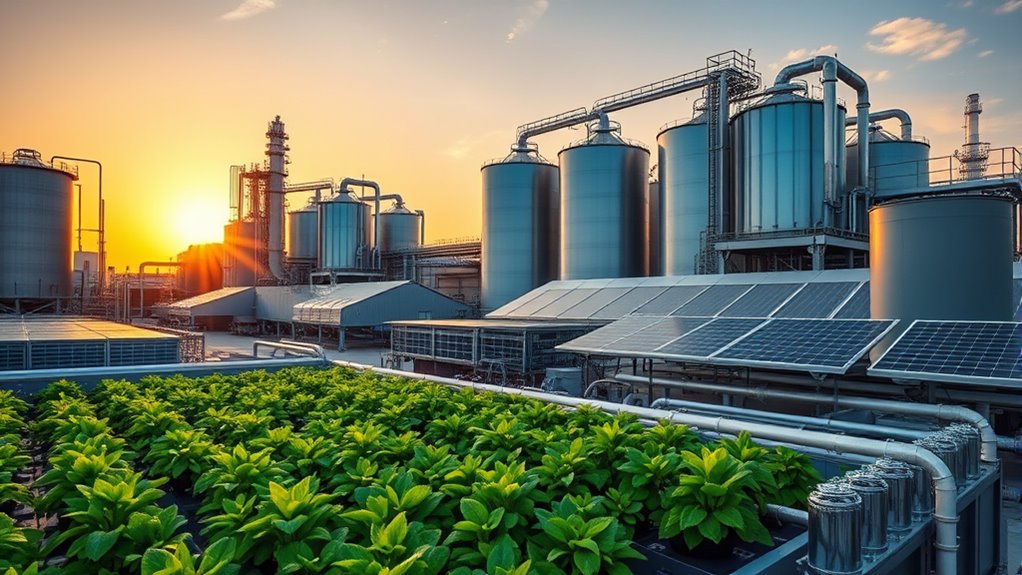The chemical sector is actively adopting circular economy practices by focusing on resource reduction, innovative recycling technologies, and designing for disassembly. Companies are optimizing resources, supporting regulatory incentives, and forming partnerships to scale sustainable solutions. Challenges like environmental risks and high energy costs persist, but benefits such as lower emissions and cost savings drive progress. Learning about industry strategies and collaborations will show you how this sector is shaping a more sustainable future.
Key Takeaways
- The chemical sector is adopting resource-efficient processes, recycling, and designing for disassembly to extend material lifecycles.
- Industry initiatives include chemical recycling, CCU, and digital tools to optimize supply chains and promote circular operations.
- Collaboration among companies, governments, and NGOs accelerates innovation and supports market development of sustainable chemicals.
- Regulatory support and market incentives like carbon pricing encourage investment in renewable feedstocks and recycling technologies.
- Industry standards such as CTI v4.0 enable measurement and monitoring of progress toward circularity goals.
Embracing the Principles of Circularity in the Chemical Industry

Have you considered how embracing the principles of circularity can transform the chemical industry? By focusing on reducing resource consumption, you can minimize reliance on fossil and finite resources during manufacturing and product use. Emphasizing resource optimization Prioritizing reuse and recycling helps extend material lifecycles, decreasing the need for virgin raw materials. Designing products with disassembly in mind makes reuse safer and more efficient, while reprocessing chemical intermediates reduces environmental impact. Recycling efforts close material loops, turning waste into valuable inputs and cutting disposal. Implementing cleaner, energy- and water-efficient processes not only conserves resources but also boosts sustainability.
Overcoming Challenges in Chemical Recycling and Recovery

While embracing the principles of circularity offers many benefits, the chemical industry faces significant hurdles in implementing effective recycling and recovery methods. Environmental concerns are a major challenge, as chemical recycling can release toxins into air, water, and soil, harming ecosystems. Only 11 plants have been built in the U.S., highlighting the limited scale and potential environmental risks associated with current facilities. The lack of extensive data and transparency makes it difficult for regulators and companies to assess environmental impacts accurately. High energy costs and contamination issues further complicate efforts, reducing efficiency and output quality. Technological limitations hinder handling mixed or contaminated waste, while scalability remains a concern, especially under strict environmental standards. Regulatory barriers and industry resistance, driven by vested interests, slow adoption. Additionally, managing toxic byproducts and ensuring economic viability require overcoming high operational costs and market fluctuations, making widespread chemical recycling a complex, ongoing challenge. Innovations in AI Security could help optimize processes and improve monitoring of environmental impacts, potentially addressing some of these hurdles.
Unlocking Benefits Through Sustainable Circular Practices

Implementing sustainable circular practices in the chemical sector opens significant benefits that drive both environmental and economic gains. By using renewable feedstocks, you reduce reliance on fossil fuels and cut carbon emissions. The chemical industry aims to lead the systemic transition to a circular economy. Advanced recycling technologies enable you to break down plastics into reusable monomers, minimizing waste and decreasing the need for virgin materials. Encouraging Extended Producer Responsibility (EPR) pushes you to design products with recyclability in mind, extending their lifecycle. Embracing reuse and recycling methods at product end-of-life further reduces environmental impacts. Engaging stakeholders across industries, governments, NGOs, and academia fosters collaboration and innovation. These practices not only lower emissions and waste but also create economic opportunities, boost resource efficiency, and strengthen your company’s sustainability profile, paving the way for a more resilient, competitive chemical industry.
Strategic Approaches to Facilitate Industry Transition

To successfully adopt sustainable circular practices in the chemical sector, you need strategic frameworks that align policy, technology, and business operations. Start by leveraging harmonized metrics like Circular Transition Indicators (CTI v4.0) to assess circularity consistently. Incorporate signs of spoilage such as ensuring the purity of recycled materials to maintain product quality. Support regulatory priorities such as chemical recycling for non-mechanically recyclable materials, reducing reliance on virgin fossil resources. Implement market incentives like carbon pricing and tax credits to promote circular product development. Foster public-private partnerships to de-risk investments and scale sustainable feedstocks. Adopt circular operational models, including closed-loop systems, chemical recycling, and industrial symbiosis networks to minimize waste and diversify resources. Redesign supply chains with material passports, reverse logistics, and digital twins to optimize reuse, while standardizing safety and environmental credentials through lifecycle assessments and traceability tools.
The Role of Innovation and Collaboration in Advancing Circularity

Innovation and collaboration are indispensable drivers propelling the chemical sector toward a more circular economy. You can leverage disruptive technologies to develop new processes that reduce waste and emissions, while renewable feedstocks help create sustainable materials. Incorporating natural materials and design principles from sectors like the farmhouse bedroom concept can inspire more eco-friendly product development. Advancing waste stewardship through innovative recycling methods ensures secondary materials are reused efficiently, boosting circularity. Collaboration across industries is crucial; by partnering with sectors, NGOs, governments, and academia, you can share knowledge, align goals, and accelerate progress. Value chain partnerships and cross-sectoral innovation maximize impacts, fostering global cooperation. These efforts open new revenue streams, lower waste management costs, and enhance operational efficiency. Ultimately, combining innovation and collaboration helps develop sustainable products, implement closed-loop systems, and establish supportive policies, propelling your organization toward a resilient, circular future.
Aligning Chemical Sector Goals With Global Sustainability Targets

Aligning the goals of the chemical sector with global sustainability targets requires a proactive approach that integrates environmental commitments into core business strategies. You need to adopt industry-specific carbon reduction targets, such as those from the Science Based Targets initiative (SBTi), which set sector-aligned carbon budgets and pathways to net-zero.
This involves developing strategies to cut emissions across scopes 1, 2, and the entire value chain, reflecting the sector’s significant contribution to CO2 emissions. Leading companies like BASF embed sustainability into their strategies, focusing on emissions, resource efficiency, and lifecycle management.
Additionally, you should invest in low- and zero-carbon technologies—electrification, green hydrogen, bio-based feedstocks—and align your goals with international frameworks like the Paris Agreement and UN SDGs. This ensures transparency, accountability, and progress toward global climate ambitions.
Pioneering Future Initiatives for a Resilient Circular Economy

How can the chemical sector lead the way in building a resilient circular economy? By advancing circular procurement and supply chain innovations, you can source materials designed for reuse and recycling, reducing reliance on virgin resources. Integrating with customer value chains enables closed-loop systems, where products are returned and recycled, extending their lifecycle.
Collaborating with suppliers helps secure secondary raw materials, lowering costs and market dependency. Developing products with disassembly features, modular designs, and bio-based chemicals enhances recyclability and sustainability. Market research can inform these innovations by identifying emerging trends and consumer preferences, ensuring the industry stays ahead.
Investing in advanced recycling technologies, like chemical recycling, allows handling complex streams and regenerating monomers for endless reuse. Additionally, shifting to renewable feedstocks and utilizing CCU tech transforms waste into valuable inputs, driving the industry toward a more resilient, circular future.
The Impact of Circular Transformation on Economic and Environmental Sustainability

The shift toward a circular economy considerably enhances both resource management and environmental sustainability in the chemical sector. By focusing on reuse and recycling, you reduce reliance on costly primary raw materials, conserve resources, and lower waste.
Increased recycling efforts and the use of secondary materials save energy—up to 90%—and water, boosting efficiency and profitability. These practices also help cut greenhouse gas emissions through low-carbon technologies and collaborative efforts, contributing to climate change mitigation.
Economically, adopting circular strategies gives your business a competitive edge, enabling the development of sustainable, profitable products while ensuring regulatory compliance. Cost savings from reduced raw material and energy use strengthen your market position.
Implementing risk assessment measures ensures that potential financial and cybersecurity risks are identified and managed proactively, supporting the resilience of your circular initiatives.
Frequently Asked Questions
How Can Regulatory Barriers Hinder Chemical Circularity Progress?
Regulatory barriers can notably slow your progress toward chemical circularity. Vague definitions, inconsistent laws, and outdated regulations create confusion and obstacles for adopting circular practices.
They can make integrating new technologies, designing recyclable products, and establishing closed-loop systems more difficult. Without clear, harmonized rules and incentives, you might face higher costs, market distortions, and investment risks, all of which hinder your ability to advance sustainable, circular solutions in the chemical sector.
What Are the Key Safety Concerns With Recycled Chemical Materials?
You should be aware that recycled chemical materials pose several safety concerns. These include the formation of new toxic substances during recycling, higher concentrations of harmful chemicals like PFAS, and the presence of NIAS that are hard to control.
Additionally, inadequate regulations can lead to contamination, exposure to carcinogens such as benzene, and environmental pollution. These risks highlight the need for strict safety standards and advanced testing for safer recycling practices.
How Does Chemical Complexity Affect Recycling Efficiency?
You might think chemical complexity makes recycling too difficult, but it actually shapes the process. The more varied the polymers, the more challenging it’s to achieve high efficiency because of different chemical structures.
However, advanced technologies like hydrochemolytic methods help handle mixed plastics and complex structures. By optimizing these processes, you can improve product quality, reduce waste, and boost overall recycling efficiency, moving closer to a sustainable circular economy.
What Financing Options Support Circular Economy Innovations?
You can explore various financing options that support circular economy innovations. Public funding like government grants, EU programs, and public-private partnerships help develop recycling infrastructure.
Green finance options such as sustainability-linked bonds and green loans fund sustainable projects.
Fintech platforms, crowdfunding, and blockchain enable direct investment and traceability.
Additionally, advisory services, risk-sharing facilities, and industry consortia provide expertise and resources.
These tools collectively accelerate your efforts toward a more circular, sustainable chemical sector.
How Can Consumer Demand Influence Chemical Industry Sustainability Efforts?
Your demand for eco-friendly products pushes the chemical industry to prioritize sustainability efforts.
As consumers like you show a willingness to pay more for sustainable options, companies are motivated to innovate and adopt greener practices.
Your preferences influence manufacturers to improve transparency, embrace ESG initiatives, and develop sustainable chemicals.
This creates a cycle where your choices directly shape industry strategies, encouraging companies to align with your values and meet the rising demand for environmentally responsible products.
Conclusion
By embracing circular principles, you help reduce waste and cut emissions—did you know the chemical industry could save up to 20% in resource use through recycling? Your efforts in adopting sustainable practices not only support global climate goals but also create economic opportunities. Together, you can drive innovation, foster collaboration, and build a resilient, greener future that benefits both the planet and your industry’s long-term success.









